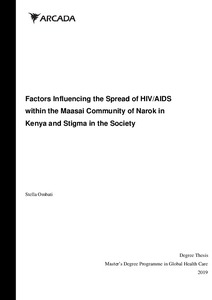Factors Influencing the Spread of HIV/AIDS within the Maasai Community of Narok in Kenya and Stigma in the Society
Ombati, Stella (2019)
Ombati, Stella
2019
All rights reserved. This publication is copyrighted. You may download, display and print it for Your own personal use. Commercial use is prohibited.
Julkaisun pysyvä osoite on
https://urn.fi/URN:NBN:fi:amk-2019120424659
https://urn.fi/URN:NBN:fi:amk-2019120424659
Tiivistelmä
Although new HIV infections have reduced significantly, global statistics show that it is one of the leading causes of death in Sub-Saharan Africa, despite the existence of varied prevention and treatment programs. Therefore, it is important to continue addressing the determinants of health and vulnerability of HIV infected people to tackle the factors that influence the spread of HIV/AIDS and the impact of stigma in the present society. Maasai people are still deeply rooted in their culture and people living with HIV/AIDS are marginalized and discriminated against due to stigma.
The study conducted a scoping literature review designed to explore the factors influencing the spread of HIV/AIDS and stigma related cases within the Maasai community of Narok in Kenya. The study aims to form the basis for a valuable platform to guide in formulating effective and sustainable policies for behaviour change among the Maasai people. After conducting an extensive literature search using PubMed, EBSCO and Google Scholar, the Arksey and O’Malley (2005) framework was adopted to analyse data.
Factors influencing the spread of HIV/AIDS within the Maasai community of Narok in Kenya include cultural and social factors, mother-to-child transmission, use of drugs and risky sexual behaviours. Stigma and discrimination are caused by the cultural understanding of HIV/AIDS, patriarchal and cultural power dynamics, gender inequality, sex and sexuality and education attainment among members of the community. In addition, immense and protracted poverty, local migration and condition of infrastructure in rural areas determines the pace of HIV/AIDS infection response.
Stigma leads to internalized negative feelings about oneself, non-adherence to medication, non-disclosure of their HIV status to others, and increased mental health problems. The culture of stigma drives the infected people to opt for herbal remedies instead of seeking the right medical help, hence affecting individuals’ care seeking behaviour.
The study conducted a scoping literature review designed to explore the factors influencing the spread of HIV/AIDS and stigma related cases within the Maasai community of Narok in Kenya. The study aims to form the basis for a valuable platform to guide in formulating effective and sustainable policies for behaviour change among the Maasai people. After conducting an extensive literature search using PubMed, EBSCO and Google Scholar, the Arksey and O’Malley (2005) framework was adopted to analyse data.
Factors influencing the spread of HIV/AIDS within the Maasai community of Narok in Kenya include cultural and social factors, mother-to-child transmission, use of drugs and risky sexual behaviours. Stigma and discrimination are caused by the cultural understanding of HIV/AIDS, patriarchal and cultural power dynamics, gender inequality, sex and sexuality and education attainment among members of the community. In addition, immense and protracted poverty, local migration and condition of infrastructure in rural areas determines the pace of HIV/AIDS infection response.
Stigma leads to internalized negative feelings about oneself, non-adherence to medication, non-disclosure of their HIV status to others, and increased mental health problems. The culture of stigma drives the infected people to opt for herbal remedies instead of seeking the right medical help, hence affecting individuals’ care seeking behaviour.
